Ron Reynolds
Demonstration
Saturday 20th July, 2013
Oils – Contemporary Still Life
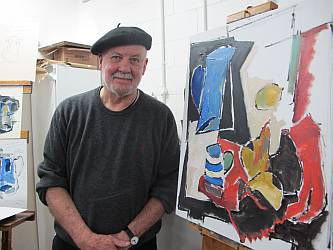 Record
Breaking Demonstration!
Record
Breaking Demonstration!
Ron was very informative, explaining the influences and ideas informing his contemporary painting style. His workbooks were evidence of his skills as a master colourist and expressive artist, as well as his drawing abilities. He has created a new record at WAA - of the 50 attendees, 22 immediately signed up to attend a workshop with him to be held at our clubrooms soon. So well done Ron!
At least two of our members, Marie Lynch and Anne Cunningham, have studied with Ron and some examples of their wonderful work was on display in our Gallery on the day, which you can see below.
Alan Close, WAA President
Ron Reynolds demonstration, 20th July 2013
Ron Reynolds is an experienced teacher who clearly knows the importance of preparation, while at the same time projecting the impression that nothing is decided; it is all impromptu, happy accidents are to be valued. A bit of a paradox. However he was here to tell us about non-realistic art. To do so he went back in art history, not far back, just as far as realism à la the tonalists such as Max Meldrum, and moving on through Bonnard, de Staël, Ivan Hitchins, Gris, Matisse, Picasso, the cubists, the fauves and so on.
Ron introduced us to some theories that apply to the appreciation and practice of modern art. Such as ‘passaging’, faceting, various views of the same object (front back top bottom of the same glass, low view high view etc. You can see it in Picasso.) He demonstrated these things very clearly and we could easily see the differences. He had pictures to illustrate the direction art has come since the 1800s. He had lists of his teaching points, headings and statements on light, colour, line, shape, volumes and the such which any good art teacher should emphasize to his students. It was an intelligent, knowledgeable and professional performance.
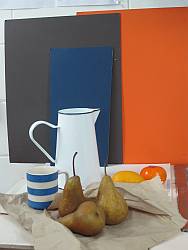 Ron
suggested that if we wanted to explore this area of art we should follow
the works of the moderns from their early to later works and see what they
were trying. In revolting against the shackles of classical art they
negated the formal rules, such as perspective, light source, a single
point of view, accurate drawing, everything that photographic realism
would have us ‘get right’. He said that it was OK to take photographs but
not to copy them. Analyse them but get your own version of what matters in
them. Don’t compete with the photo, use it to make sketches that appeal to
you. Your art should be you. Struggle away from photographic
realism to something that expresses you.
Ron
suggested that if we wanted to explore this area of art we should follow
the works of the moderns from their early to later works and see what they
were trying. In revolting against the shackles of classical art they
negated the formal rules, such as perspective, light source, a single
point of view, accurate drawing, everything that photographic realism
would have us ‘get right’. He said that it was OK to take photographs but
not to copy them. Analyse them but get your own version of what matters in
them. Don’t compete with the photo, use it to make sketches that appeal to
you. Your art should be you. Struggle away from photographic
realism to something that expresses you.
To demonstrate one way of ’being you’ he started the demonstration. His board was an offcut from framing. They are very good for early attempts using oils. He does a lot of try-outs, and discards most of them. He left his demo pieces with us. It shows that you cannot have the attitude that ‘I did that. It is sacred’.
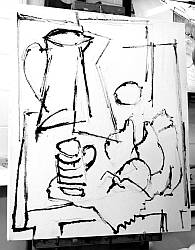 During
afternoon tea he worked up a black line sketch on a white box canvas of
the jug/pears/cup arrangement that he had made at the start, emphasizing
lines and shapes which were in many ways at variance with what you could
see. He broke lots of rules. He took a stick dipped in ink and sketched a
still life set-up of jug, cup and pears. Not accurately. It had tilted
verticals, crooked lines, off-centre ovals, scratchy lines. But it did
look ‘modern’.
During
afternoon tea he worked up a black line sketch on a white box canvas of
the jug/pears/cup arrangement that he had made at the start, emphasizing
lines and shapes which were in many ways at variance with what you could
see. He broke lots of rules. He took a stick dipped in ink and sketched a
still life set-up of jug, cup and pears. Not accurately. It had tilted
verticals, crooked lines, off-centre ovals, scratchy lines. But it did
look ‘modern’.
Then he put out some colours on his palette. He squeezed sausage line shapes so that you can mix one end and get it dirty but still have some clean colour on the other end. Good idea. He wasn’t fussy about brand names of the paints. He probably used the one brush throughout the demonstration, wiping it with a rag. He held it wrist above, like a rapier, as a fencer does, at a long distance from his enemy. Tight, close use of the brush produces tight art. Get some full arm movements.
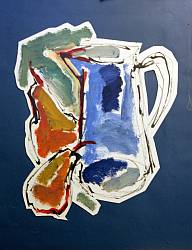 One
finished version of Ron's demonstration
One
finished version of Ron's demonstration
He altered the perspective, tilted verticals, arrangements, shapes. Nothing is permanent at this stage, anything can be changed. He painted it in with colour. The darks came first. A black line became a white line on black. The blacks tended to go to the edges and framed or contained the subject. As he worked his influences (Matisse, Picasso etc.) came in and influenced his decisions, although they were not verbalised. They wander through his working day. One that he quoted was from de Staël: “The only way I can advance is from one accident to another.”
So this is the way a non-realist artist works.
Colin Browne, WAA Secretary
Contemporary Artworks by WAA Members (see also the WAA Gallery pages)
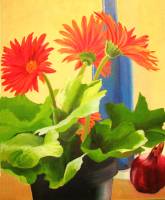
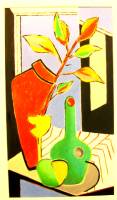
Anne Cunningham, Still Lifes
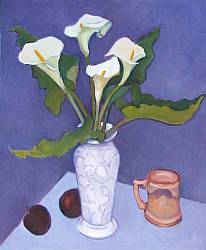
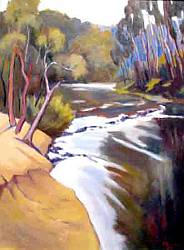
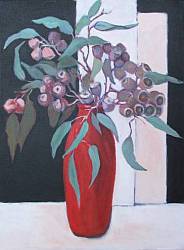
Marie Lynch, Still Lifes and Landscape